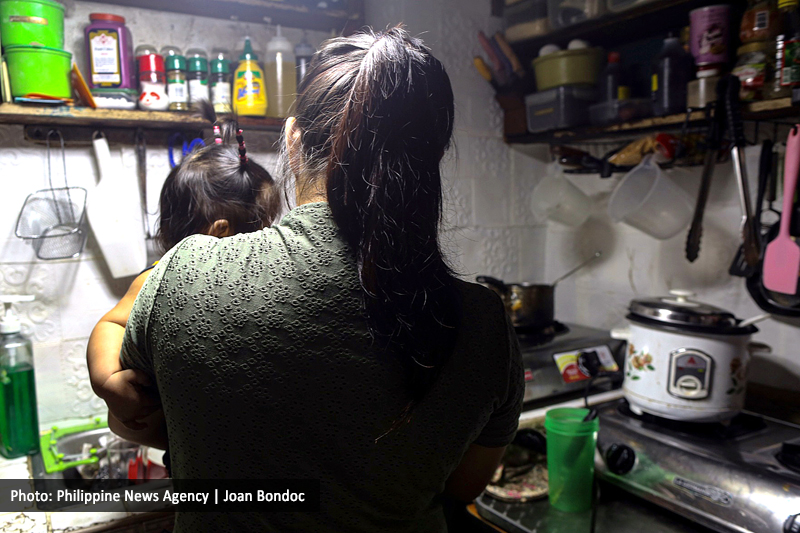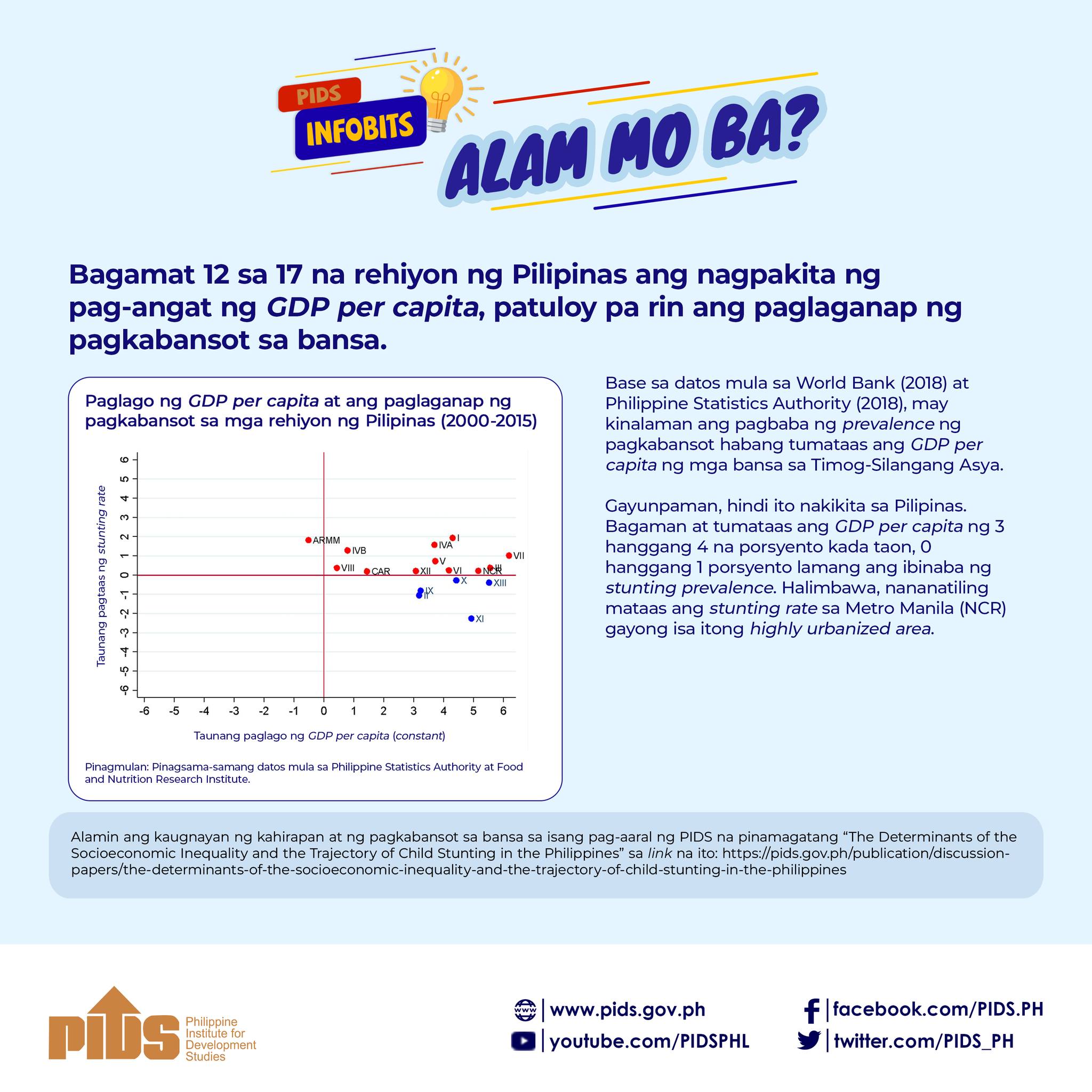The unpaid household chores and care work rendered by women is valued at 20% of the Philippines’ gross domestic product (GDP), according to Research Fellow Michael M. Abrigo of the Philippine Institute for Development Studies (BusinessWorld April 2, 2019). This is quantified at nearly P2 trillion. According to 2015 data, only 2% of males help out with the house and care work of their spouses and mothers (Ibid.).
The objective of the PIDS study: “We want to bring home the message that there’s value in housework, na hindi ibig sabihin nito na porke’t nasa bahay sila ay walang value ‘yung oras nila (it doesn’t mean just because they’re at home their time does not have value). We want to convert these time units into monetary units” (Ibid.).
The PIDS used the National Transfer Account (NTA) to check whether activities performed by women doing unpaid work translated to economic activity that contributes to GDP. The National Time Transfer Account (NTTA) measured the time spent on unpaid work by women (Ibid.). Impressive, but such algorithms have been used to quantify unpaid housework by women before — and have the components of that almighty GDP been revised to include such “intangibles” as this factor?
GDP has entrenched itself as the ultimate gauge for determining a country’s economic performance. Perhaps it can be said that the GDP formula is an “invention born of necessity”, for it achieved convenient acceptance as the measurement guide for the obsessive years of rehabilitation after the World Wars of the 1940s. The “brain” most credited for the development of the GDP measure was Simon Kuznets, the 1971 Nobel Memorial Prize in Economic Sciences “for his empirically founded interpretation of economic growth which has led to new and deepened insight into the economic and social structure and process of development.”
Kuznets (1901 – 1985), of Jewish-Lithuanian descent, was an immigrant to the United States after the Civil War in Russia that subsequently settled in communism as the political and economic ideology. After a doctorate in Economics from Columbia University, Kuznets worked for the National Bureau of Economic Research (NBER) and was professor in economics at the University of Pennsylvania, John Hopkins University and for the decade before his retirement, at Harvard University. Thus his directions were in econometrics, studying manifestations in identified and correlated indicators, as these are statistically monitored and empirically tested and vetted against theoretical cycles and expected trending.
Kuznets helped the U.S. Department of Commerce to standardize the measurement of GNP. However, he disagreed of its use as a general indication of welfare (only as a limited measure of production), writing that “the welfare of a nation can scarcely be inferred from a measure of national income” (Simon Kuznets, 1934. “National Income, 1929–1932”). He wanted to include the measurement of certain “intangibles” as part of GDP, (e.g. the cost of pollution) and particularly the value of unpaid housework — because he considered these as important components of production (www.econlib.org). Kuznets and sympathetic economists were “vetoed” by the “utilitarians” — those who wanted to include only measurable production. Since then, only quantifiable inputs are measured and imbedded in GDP.
The feminist movements, even mixed-gender rights groups, and independent-thinking academics have not ceased to question the inadequacy of GDP that did not include unpaid housework, mostly done by women, like cleaning, cooking, child or elder care. “Without a wife to tend to the children and the home, how would a male factory laborer have the time or the energy to fulfill his stereotypical role as the breadwinner,” a women’s rights group in India asked? (shethepeople.tv/news June 28, 2018). “Economists didn’t know how to count it when they created the GDP in the 1940s…there is complexity in assigning value where no money changes hands,” economists admitted. The reason they defined GDP as goods and services is because those are easy to measure” (marketwatch.com Jan 17, 2001). At the Beijing United Nations’ World Conference on Women in 1995, some 50 countries declared to have done time- use surveys, or planned to do them, in the effort to make GDP more relevant and “accurate”.
And the PIDS did its own time-use surveys to value the unpaid household chores and care work rendered by women in the Philippines. What do we do with that information? In the input-output balance of economic production, who should pay for this “unaccounted” estimated 20% of GDP? Sociologist Constance Gager must have half-joked when she said, “We might make a start by asking husbands to pay their wives who stay home an actual salary that’s taxable. Those taxes on that amount could help pay for other women whose husbands are not so wealthy” (Ibid.).
The Asian Development Bank analyzed the unpaid work of women in the Philippines: “There is a strong gendered division of domestic labor with women having primary responsibility for household and care work and a higher total work burden relative to men. In the Philippines, women provide 84% of the total household time allocated to child care. Gendered social norms contribute to women having greater responsibility for, and time commitments to, domestic and unpaid care work, and this has been slow to change despite women’s increased participation in, and time allocated to, paid work. Relatively high fertility rates continue to raise the demand for women’s unpaid labor, especially given the low provision of child care services”
In the matriarchal society of the Philippines, the family, which is the core social unit, is ruled and nurtured by the women. There are about 28.5 million Filipino women between the ages of 15 and 64 (UN factbook Dec 4, 2015), which includes those in the child-bearing years and those who are already mothers of at least two generations. There were about 20 million households in the same census year 2010 (psa.gov.ph Aug 30, 2012), which number we could borrow to extrapolate the number of mothers, assuming there is a mother in each household of 5 persons.
A side story: a widow left with minor children is appointed by the courts as guardian and administrator of the children’s share in the deceased’s estate (half of the conjugal property goes to equal shares to the heirs — to the wife and each child). Among the duties and responsibilities of the surviving spouse is to feed, clothe, shelter, educate and keep the minor children healthy — all of which need money. Thus, the court would require that surviving spouse would make a yearly accounting of the expenses for rearing the minor children, deductible from the share of the children. That is ridiculous, a young widow said. She waived her right to be “reimbursed” for caring for her own children, orphaned too early. Scandalous and irreverent to charge for love.
No, the household chores and care work willingly rendered by women for their loved ones cannot be dehumanized and downgraded to a monetary value for exchange in the production line of capitalist GDP. Better to uphold mothers’ loving sacrifices by positive recognition in a Quality of Life or perhaps a Happiness Index.
Happy Mothers’ Day!











